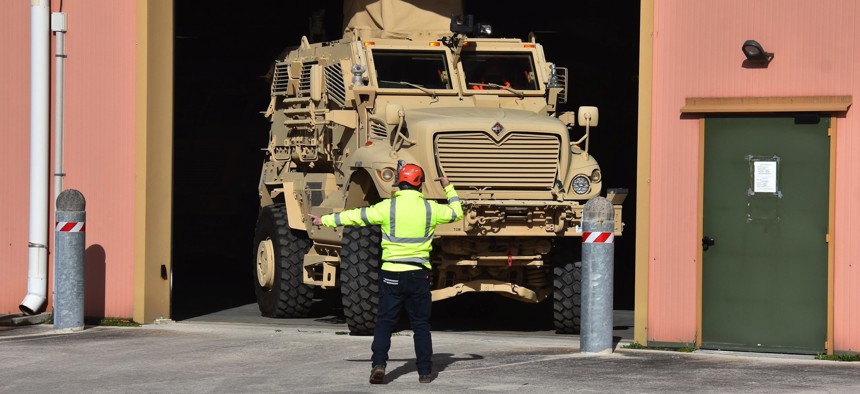
In February 2021, members of the 405th Army Field Support Brigade pulled 100 Mine Resistant Ambush Protected vehicles from the Army Preposition Stock-2 site at Leghorn Army Depot, Italy. U.S. Army / Chiara Mattirolo
Army Aims to Fix Storage Program that Sent Defective Humvees to Ukraine
The service’s prepositioned-stores effort is key to U.S. war plans.
The Army is re-evaluating how it stores equipment abroad after the Defense Department’s inspector general found that an Army unit and a contractor sent Humvees with rotted tires to Ukraine.
Army senior leaders will “review all aspects of this instance and apply the necessary improvements” to the Army Prepositioned Stocks program, said service spokesperson Jason Waggoner. “The Army is looking at all recommendations to make necessary changes to the APS program.”
The service keeps large stores of equipment abroad at seven sites, which allows soldiers to quickly deploy to those locations without first having to ship bulky items like tanks, self-propelled artillery, or trucks.
Soon after Russia invaded Ukraine last year, the Army ordered the 401st Army Field Support Battalion in Kuwait to send equipment to Ukraine, including all six of its M777 howitzers and all 29 of its M1167 Humvees.
But inspections revealed that the M777s had problems with their firing mechanisms, some of which could have killed their own gun crews. Meanwhile, all but one of the Humvees had rotted tires, which were discovered after one vehicle’s tire and its spare shredded as the Army attempted to hand them off to Ukraine.
On May 25, the Defense Department inspector general released a report that blamed the Army and its contractor for not performing certain maintenance checks.
In their response to the report, Army Materiel Command officials accepted some of its recommendations, but also noted that Congress had provided less money for maintenance than the Army requested. They also disagreed that the contractor was obligated to maintain the equipment at the level cited by the inspector general.
Army regulations do appear to allow some wiggle room, as they distinguish between the conditions under which an item is stored and the conditions under which it is issued, said Elvira Loredo, an associate program director at the RAND Corporation,
“The IG report raises good points and should force a discussion about APS,” Loredo said.
“However, I don’t think the topic of the discussion should be the contractor. It should be how the Army and the Department of Defense set requirements and standards for APS management, how it reports the readiness of the equipment, and how it funds that readiness.”
The inspector general cited the same unit and contractor, Amentum Services, for similar issues in 2018.
The Army also experienced some problems when it used prepositioned stocks in Europe to help soldiers deploy to Europe at the start of Russia’s full-scale invasion of Ukraine in 2022.
According to a Feb. 27 inspector general report, contractors failed to adequately maintain some equipment, leading to more than ten percent of equipment being less than fully ready to use. Some of these problems were due to a lack of necessary maintenance facilities.
The overall impression was better, though, with the Army and the inspector general noting the speed at which the equipment was issued.
